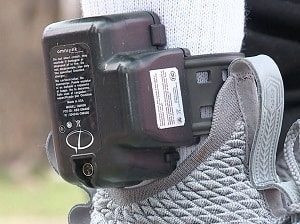Ankle Monitor Cost
Last Updated on August 22, 2021
Written by CPA Alec Pow | Content Reviewed by ![]() CFA Alexander Popinker
CFA Alexander Popinker
For those who have been sentenced to wear them as punishment and rehabilitation alike, the use of these devices has revolutionized criminal justice over time. Originally, these devices were only used by large-scale criminals such as thieves and drug dealers during the transition period between prison sentences. Nowadays almost anyone can be fitted with one if there is a real suspicion that he or she will commit another crime while out free.
Ankle monitors are an easy way to keep track of offenders in the community. The device sends out a radio frequency signal that can be tracked. The best part about these devices is that if you try and step outside your allowed range without notifying authorities beforehand then this would send out an automatic alarm warning them of what’s happened. If for any reason, someone tries to remove or tamper with their ankle monitor device then this can be easily detected as well.
In order to avoid jail time, law offenders pay for the cost of an ankle monitor. In return, they get a chance at correcting their lives and continuing with everyday life rather than serve a sentence in prison. The only people who qualify are those with minor offenses, but at least they get this opportunity instead of going straight into custody without any chance whatsoever.
How much does an ankle monitor cost?
Ankle monitors are one of the newest technologies to help law enforcement. These devices, which can be as small and thin as a watch band or bracelet, typically cost between $5-$20 per day depending on what state you live in. For instance, someone who lives in Oregon pays just $8 for each 24-hour period.
The monitor itself costs the government anywhere from $800 -$1,500 per device. The price depends entirely on where your residence is set up as most states charge around $200+ for setup fee plus daily usage fees.
House arrest is a more affordable option than prison in many cases, and this cost could be even lower for those with low incomes. FindLaw.com states that the average price of house arrest per year is $6,000, which means an individual will pay about $5 to $15 on any given day while wearing their monitoring equipment and enjoy their daily life at home.
In a Government Technology article, the publisher is talking about the life of people who wear ankle monitors in La Crosse County, Wisconsin. According to local government, offenders must pay a daily monitor fee which will vary anywhere from $7 if they are on bond and only need it temporarily to as high as $12 per day for those who have served their sentence but still wear an ankle monitor as part of parole requirements.
You might also like our article about the cost of alcohol testers.
The Daily Kos reports that a man in South Carolina had to pay a $179.50 setup fee, plus a per-day fee of $9.25 for his ankle monitor.
In Riverside County, CA you need to pay $7 for a regular unit and up to $12 per day if you want a cellular unit.
NPR interviewed a man who lives in Augusta, Georgia and found out that he was paying $12 for a wristband with an alcohol monitor strapped to it. The bracelet also costs him about $50 to set up and $39 every month for the probation company overseeing his device. The cost of these bracelets is supported by those wearing them in all 49 states in America except for Hawaii.
If you’re looking after an ankle monitor for personal use, it can cost anywhere between $150-$250 depending on the brand and where it is purchased from.
Ankle monitor details
 Ankle monitors are a popular way to monitor the location and movements of those who are on bail pending a trial or put on house arrest. They typically come with some sort of tamper-proof protection, using radio frequency (RF) waves that allow satellites and cellphone towers to track an offender’s movement through their phone signals.
Ankle monitors are a popular way to monitor the location and movements of those who are on bail pending a trial or put on house arrest. They typically come with some sort of tamper-proof protection, using radio frequency (RF) waves that allow satellites and cellphone towers to track an offender’s movement through their phone signals.
You may think that your home is the last place you could be monitored, but these days it’s not always so. These monitors are waterproof and have built-in listening features for conversations but can also pick up other sounds around the house like TV or music if they’re close enough to a speaker.
There are ankle monitors that not only keep track of your location but will also tell how drunk you are. The continuous remote alcohol monitor, or SCRAM, is designed to detect the level of booze in your body. It can test sweat and would alert authorities if you were drinking too much.
What are the extra costs?
As mentioned before, each state may apply a one-time setup fee, which varies somewhere between $100 and $200.
In some circumstances, a monthly fee will be charged that goes to the probation company monitoring your bracelet. This is somewhere between $30-$60.
How can I save money?
There are some states that have a sliding income scale. They charge lower rates to those who make less, and higher rates for those earning more. Talk with your local court if you want to see whether or not this policy is in effect where you live.


Leave a Reply
Want to join the discussion?Feel free to contribute!